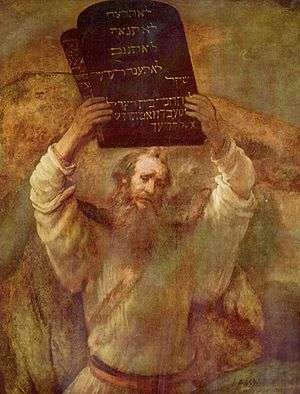Book of Exodus
The Book of Exodus is the second book of the Bible. It describes the Israelites' deliverance from slavery in the Exodus from Egypt through the hand of Yahweh, the leadership of Moses, the revelations at the biblical Mount Sinai, and the subsequent "divine indwelling" of God with Israel.[1]

 | |||||||||||||||||||||||||||||||||||||||||
| Tanakh (Judaism) | |||||||||||||||||||||||||||||||||||||||||
|---|---|---|---|---|---|---|---|---|---|---|---|---|---|---|---|---|---|---|---|---|---|---|---|---|---|---|---|---|---|---|---|---|---|---|---|---|---|---|---|---|---|
|
|||||||||||||||||||||||||||||||||||||||||
| Old Testament (Christianity) | |||||||||||||||||||||||||||||||||||||||||
|
|||||||||||||||||||||||||||||||||||||||||
| Bible portal | |||||||||||||||||||||||||||||||||||||||||
Exodus is traditionally ascribed to Moses himself, but modern scholars see its initial composition as a product of the Babylonian exile (6th century BCE), based on earlier written and oral traditions, with final revisions in the Persian post-exilic period (5th century BCE).[2][3] Carol Meyers, in her commentary on Exodus, suggests that it is arguably the most important book in the Bible, as it presents the defining features of Israel's identity—memories of a past marked by hardship and escape, a binding covenant with God, who chooses Israel, and the establishment of the life of the community and the guidelines for sustaining it.[4] The consensus among scholars is that the story in the Book of Exodus is best understood as a myth, and does not accurately describe historical events.[5]
Name
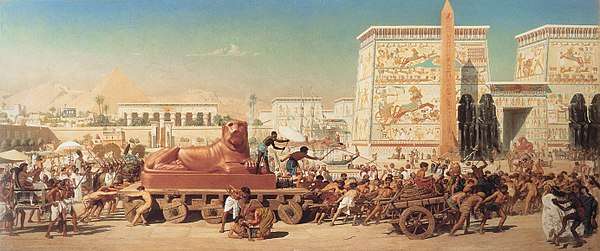
The English name Exodus comes from the Ancient Greek: ἔξοδος, romanized: éxodos, lit. 'way out', from ἐξ-, ex-, 'out' and ὁδός, hodós, 'path', 'road'.
In Hebrew the book's title is שְׁמוֹת, shemōt, "Names", from the beginning words of the text: "These are the names of the sons of Israel" (Hebrew: וְאֵלֶּה שְׁמֹות בְּנֵי יִשְׂרָאֵל).[6]
Structure
There is no unanimous agreement among scholars on the structure of Exodus. One strong possibility is that it is a diptych (i.e., divided into two parts), with the division between parts 1 and 2 at the crossing of the Red Sea or at the beginning of the theophany (appearance of God) in chapter 19.[7] On this plan, the first part tells of God's rescue of his people from Egypt and their journey under his care to Sinai (chapters 1–19) and the second tells of the covenant between them (chapters 20–40).[8]
Summary
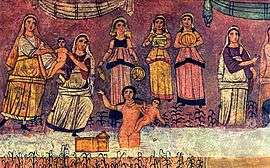
Jacob's sons and their families join their brother Joseph in Egypt, where they begin to grow in number. Egypt's new Pharaoh, who doesn't remember how Joseph had saved Egypt from famine 400 years earlier, is fearful that the Israelites could become a fifth column so he forces the Israelites into slavery and orders the throwing of all newborn boys into the Nile. A Levite woman (Jochebed, according to other sources) saves her baby by setting him adrift on the river Nile in an ark of bulrushes. Pharaoh's daughter finds the child, names him Moses, and brings him up as her own.
Aware of his origins, an adult Moses kills an Egyptian overseer beating a Hebrew slave and flees into Midian to escape punishment. There he marries Zipporah, daughter of Midianite priest Jethro, and encounters God in a burning bush. Moses asks God for his name, to which God replies: "I Am that I Am," the book's explanation for the origins of the name Yahweh, as God is thereafter known. God tells Moses to return to Egypt and lead the Hebrews into Canaan, the land promised to Abraham. On the way to Egypt God seeks to kill Moses, but Zipporah saves his life.
Moses returns to Egypt and fails to convince the Pharaoh to release the Israelites. God smites the Egyptians with ten terrible plagues, among them a river of blood, an outbreak of frogs, and the death of all firstborn sons. Moses leads the Israelites out of bondage, prompting a final pursuit through the Red Sea by the forces of Pharaoh when Pharaoh reneges on his coerced consent.
As desert life proves arduous, the Israelites complain and long for Egypt, but God miraculously provides manna for them to eat and water to drink. The Israelites arrive at the mountain of God, where Moses's father-in-law Jethro visits Moses; at his suggestion Moses appoints judges over Israel. God asks whether they will agree to be his people. They accept. The people gather at the foot of the mountain, and with thunder and lightning, fire and clouds of smoke, the sound of trumpets, and the trembling of the mountain, God appears on the peak, and the people see the cloud and hear the voice (or possibly sound) of God. God tells Moses to ascend the mountain. God pronounces the Ten Commandments (the Ethical Decalogue) in the hearing of all Israel. Moses goes up the mountain into the presence of God, who pronounces the Covenant Code of ritual and civil law and promises Canaan to them if they obey. Moses comes down the mountain and writes down God's words, and the people agree to keep them. God calls Moses up the mountain, where he remains for forty days and forty nights, at the conclusion of which he returns, bearing the set of stone tablets.
God gives Moses instructions for the construction of the tabernacle so that God may dwell permanently among his chosen people, along with instructions for the priestly vestments, the altar and its appurtenances, procedures for ordination of priests, and the daily sacrifice offerings. Aaron becomes the first hereditary high priest. God gives Moses the two tablets of stone containing the words of the ten commandments, written with the "finger of God".[9]

While Moses is with God, Aaron casts a golden calf, which the people worship. God informs Moses of their apostasy and threatens to kill them all, but relents when Moses pleads for them. Moses comes down from the mountain, smashes the stone tablets in anger, and commands the Levites to massacre the unfaithful Israelites. God commands Moses to construct two new tablets. Moses ascends the mountain again, where God dictates the Ten Commandments for Moses to write on the tablets.
Moses descends from the mountain with a transformed face; from that time onwards he must hide his face with a veil. Moses assembles the Hebrews and repeats to them the commandments he has received from God, which are to keep the Sabbath and to construct the Tabernacle. The Israelites do as they are commanded. From that time God dwells in the Tabernacle and orders the travels of the Hebrews.
Composition
Authorship
Jewish and Christian tradition viewed Moses as the author of Exodus and the entire Torah, but by the end of the 19th century the increasing awareness of discrepancies, inconsistencies, repetitions and other features of the Pentateuch had led scholars to abandon this idea.[10] In approximate round dates, the process which produced Exodus and the Pentateuch probably began around 600 BCE when existing oral and written traditions were brought together to form books recognisable as those we know, reaching their final form as unchangeable sacred texts around 400 BCE.[11]
Sources
Although patent mythical elements are not so prominent in Exodus as in Genesis, ancient legends may have an influence on the book's form or content: for example, the story of the infant Moses's salvation from the Nile is argued to be based on an earlier legend of king Sargon of Akkad, while the story of the parting of the Red Sea may trade on Mesopotamian creation mythology. Similarly, the Covenant Code (the law code in Exodus 20:22–23:33) has some similarities in both content and structure with the Laws of Hammurabi. These influences serve to reinforce the conclusion that the Book of Exodus originated in the exiled Jewish community of 6th-century BCE Babylon, but not all the sources are Mesopotamian: the story of Moses's flight to Midian following the murder of the Egyptian overseer may draw on the Egyptian Story of Sinuhe.[12]
Genre: history vs. myth
The overwhelming consensus among scholars is that the story in the Book of Exodus is best understood as a myth and cannot be treated as history in any verifiable sense.[5] While archaeology has found traces left by even small bands of hunter-gatherers in the Sinai, there is no evidence at all for the large body of people described in the Exodus story: "The conclusion – that Exodus did not happen at the time and in the manner described in the Bible – seems irrefutable [...] repeated excavations and surveys throughout the entire area have not provided even the slightest evidence".[13] Instead, modern archaeology suggests continuity between Canaanite and Israelite settlement, indicating a primarily Canaanite origin for Israel.[14][15]
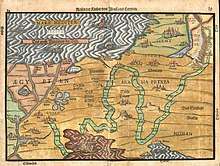
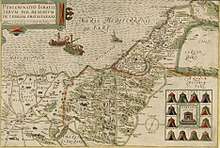
While all but the most conservative scholars reject the biblical account of the Exodus,[5] a majority still believes that the story conserves some historical basis, [16][17] though disagreeing widely about what that historical kernel might have been.[18] Kenton Sparks refers to it as "mythologized history."[19] Some scholars, associated with the interpretative school of Biblical minimalism,[20] show more skepticism towards ascribing any historicity to the Exodus,[21] with some arguing that the myth has its origins in the exilic and post-exilic Jewish communities and has little or no roots in a real historical event.[22]
Themes

Salvation
Biblical scholars describe the Bible's theologically-motivated history writing as "salvation history", meaning a history of God's saving actions that give identity to Israel – the promise of offspring and land to the ancestors, the Exodus from Egypt (in which God saves Israel from slavery), the wilderness wandering, the revelation at Sinai, and the hope for the future life in the promised land.[23]
Theophany
A theophany is a manifestation (appearance) of a god – in the Bible, an appearance of the God of Israel, accompanied by storms – the earth trembles, the mountains quake, the heavens pour rain, thunder peals and lightning flashes.[24] The theophany in Exodus begins "the third day" from their arrival at Sinai in chapter 19: Yahweh and the people meet at the mountain, God appears in the storm and converses with Moses, giving him the Ten Commandments while the people listen. The theophany is therefore a public experience of divine law.[25]
The second half of Exodus marks the point at which, and describes the process through which, God's theophany becomes a permanent presence for Israel via the Tabernacle. That so much of the book (chapters 25–31, 35–40) describes the plans of the Tabernacle demonstrates the importance it played in the perception of Second Temple Judaism at the time of the text's redaction by the Priestly writers: the Tabernacle is the place where God is physically present, where, through the priesthood, Israel could be in direct, literal communion with him.[26]
Covenant
The heart of Exodus is the Sinaitic covenant.[27] A covenant is a legal document binding two parties to take on certain obligations towards each other.[28] There are several covenants in the Bible, and in each case they exhibit at least some of the elements in real-life treaties of the ancient Middle East: a preamble, historical prologue, stipulations, deposition and reading, list of witnesses, blessings and curses, and ratification by animal sacrifice.[29] Biblical covenants, in contrast to Eastern covenants in general, are between a god, Yahweh, and a people, Israel, instead of between a strong ruler and a weaker vassal.[30]
Election of Israel
God elects Israel for salvation because the "sons of Israel" are "the firstborn son" of the God of Israel, descended through Shem and Abraham to the chosen line of Jacob whose name is changed to Israel. The goal of the divine plan in Exodus is a return to humanity's state in Eden, so that God can dwell with the Israelites as he had with Adam and Eve through the Ark and Tabernacle, which together form a model of the universe; in later Abrahamic religions Israel becomes the guardian of God's plan for humanity, to bring "God's creation blessing to mankind" begun in Adam.[31]
Judaism's weekly Torah portions in the Book of Exodus
- Shemot, on Exodus 1–5: Affliction in Egypt, discovery of baby Moses, Pharaoh
- Va'eira, on Exodus 6–9: Plagues 1 to 7 of Egypt
- Bo, on Exodus 10–13: Last plagues of Egypt, first Passover
- Beshalach, on Exodus 13–17: Parting the Sea, water, manna, Amalek
- Yitro, on Exodus 18–20: Jethro’s advice, The Ten Commandments
- Mishpatim, on Exodus 21–24: The Covenant Code
- Terumah, on Exodus 25–27: God's instructions on the Tabernacle and furnishings
- Tetzaveh, on Exodus 27–30: God's instructions on the first priests
- Ki Tissa, on Exodus 30–34: Census, anointing oil, golden calf, stone tablets, Moses radiant
- Vayakhel, on Exodus 35–38: Israelites collect gifts, make the Tabernacle and furnishings
- Pekudei, on Exodus 38–40: Setting up and filling of The Tabernacle
See also
References
Citations
- Sparks 2010.
- Johnstone 2003, p. 72.
- Finkelstein & Silberman 2002, p. 68.
- Meyers, p. xv.
- Collins 2005, p. 46.
- Dozeman 2009, p. 1.
- Meyers, p. 17.
- Stuart, p. 19.
- Exodus 31:18; Deuteronomy 9:10
- Meyers 2005, p. 16.
- McEntire 2008, p. 8.
- Kugler & Hartin 2009, p. 74.
- Finkelstein & Silberman 2001, p. 63.
- Barmash 2015, p. 4.
- Shaw 2002, p. 313.
- Faust 2015, p. 476.
- Redmount 2001, p. 87.
- Geraty 2015, p. 55.
- Sparks 2010, p. 73.
- Davies 2004, p. 23-24.
- Moore & Kelle 2011, p. 95.
- Russell 2009, pp. 11-14.
- Dozeman, p. 9.
- Dozeman, p. 4.
- Dozeman, p. 427.
- Dempster, p. 107.
- Wenham, p. 29.
- Meyers, p. 148.
- Meyers, pp. 149–150.
- Meyers, p. 150.
- Dempster, p. 100.
Bibliography
- Barmash, Pamela (2015). "Out of the Mists of History: The Exaltation of the Exodus in the Bible". In Barmash, Pamela; Nelson, W. David (eds.). Exodus in the Jewish Experience: Echoes and Reverberations. Lexington Books. pp. 1–22. ISBN 9781498502931.CS1 maint: ref=harv (link)
- Childs, Brevard S (1979). The Book of Exodus. Eerdmans. ISBN 9780664229689.CS1 maint: ref=harv (link)
- Collins, John J. (2005). The Bible After Babel: Historical Criticism in a Postmodern Age. Eerdmans. ISBN 9780802828927.CS1 maint: ref=harv (link)
- Davies, Graham (2004). "Was There an Exodus?". In Day, John (ed.). In Search of Pre-exilic Israel: Proceedings of the Oxford Old Testament Seminar. Continuum. pp. 23–40. ISBN 9780567082060.CS1 maint: ref=harv (link)
- Dempster, Stephen G (2006). Dominion and Dynasty. InterVarsity Press. ISBN 9780830826155.CS1 maint: ref=harv (link)
- Dozeman, Thomas B (2009). Commentary on Exodus. Eerdmans. ISBN 9780802826176.CS1 maint: ref=harv (link)
- Dozeman, Thomas B (2000). "Exodus, Book of". In David Noel, Freedman; Allen C., Myers (eds.). Eerdmans Dictionary of the Bible. Eerdmans. ISBN 9789053565032.CS1 maint: ref=harv (link)
- Dozeman, Thomas B. (2010). Methods for Exodus. Cambridge University Press. ISBN 9781139487382.
- Faust, Avraham (2015). "The Emergence of Iron Age Israel: On Origins and Habitus". In Thomas E. Levy; Thomas Schneider; William H.C. Propp (eds.). Israel's Exodus in Transdisciplinary Perspective: Text, Archaeology, Culture, and Geoscience. Springer. ISBN 978-3-319-04768-3.CS1 maint: ref=harv (link)
- Finkelstein, Israel; Silberman, Neil Asher (2002). The Bible Unearthed. Simon and Schuster. ISBN 9780743223386.CS1 maint: ref=harv (link)
- Geraty, Lawrence T. (2015). "Exodus Dates and Theories". In Thomas E. Levy; Thomas Schneider; William H.C. Propp (eds.). Israel's Exodus in Transdisciplinary Perspective: Text, Archaeology, Culture, and Geoscience. Springer. pp. 55–64. ISBN 978-3-319-04768-3.CS1 maint: ref=harv (link)
- Fretheim, Terence E (1991). Exodus. Westminster John Knox Press. ISBN 9780664237349.CS1 maint: ref=harv (link)
- Houston, Walter J (1998). "Exodus". In John Barton (ed.). Oxford Bible Commentary. Oxford University Press. ISBN 9780198755005.CS1 maint: ref=harv (link)
- Johnstone, William D (2003). "Exodus". In James D. G. Dunn, John William Rogerson (ed.). Eerdmans Bible Commentary. Eerdmans. ISBN 9780802837110.CS1 maint: ref=harv (link)
- Kugler, Robert; Hartin, Patrick (2009). An Introduction to the Bible. Eerdmans. ISBN 9780802846365.CS1 maint: ref=harv (link)
- McEntire, Mark (2008). Struggling with God: An Introduction to the Pentateuch. Mercer University Press. ISBN 9780881461015.CS1 maint: ref=harv (link)
- Meyers, Carol (2005). Exodus. Cambridge University Press. ISBN 9780521002912.CS1 maint: ref=harv (link)
- Moore, Megan Bishop; Kelle, Brad E. (2011). Biblical History and Israel's Past. Eerdmans. ISBN 9780802862600.CS1 maint: ref=harv (link)
- Newman, Murray L (2000) Exodus Forward Movement Publications
- Plaut, Gunther. The Torah: A Modern Commentary (1981), ISBN 0-8074-0055-6
- Redmount, Carol A. (2001) [1998]. "Bitter Lives: Israel In And Out of Egypt". In Coogan, Michael D. (ed.). The Oxford History of the Biblical World. OUP. pp. 58–89. ISBN 9780199881482.CS1 maint: ref=harv (link)
- Gmirkin, Russell E. (2006). Berossus and Genesis, Manetho and Exodus: Hellenistic Histories and The Date of the Pentateuch. T & T Clark International. ISBN 9780567025920.CS1 maint: ref=harv (link)
- Russell, Stephen C. (2009). Images of Egypt in Early Biblical Literature. Walter de Gruyter. ISBN 9783110221718.CS1 maint: ref=harv (link)
- Shaw, Ian (2002). "Israel, Israelites". In Shaw, Ian; Jameson, Robert (eds.). A Dictionary of Archaeology. Wiley Blackwell. p. 313. ISBN 9780631235835.CS1 maint: ref=harv (link)
- Sparks, Kenton L. (2010). "Genre Criticism". In Dozeman, Thomas B. (ed.). Methods for Exodus. Cambridge University Press. ISBN 9781139487382.CS1 maint: ref=harv (link)
- Stuart, Douglas K (2006). Exodus. B&H Publishing Group. ISBN 9780805401028.CS1 maint: ref=harv (link)
- Wenham, Gordon (1979). The Book of Leviticus. Eerdmans. ISBN 9780802825223.CS1 maint: ref=harv (link)
External links
| Wikiquote has quotations related to: Book of Exodus |
| Wikisource has original text related to this article: |
| Wikimedia Commons has media related to Book of Exodus. |
- Exodus at BibleGateway.com
- Exodus at Mechon-Mamre (Jewish Publication Society translation)
- Exodus (The Living Torah) Rabbi Aryeh Kaplan's translation and commentary at Ort.org
- Shemot – Exodus (Judaica Press) translation [with Rashi's commentary] at Chabad.org
- Shmot (Original Hebrew – English at Mechon-Mamre.org)

Book of Exodus | ||
| Preceded by Genesis |
Hebrew Bible | Succeeded by Leviticus |
| Christian Old Testament | ||
